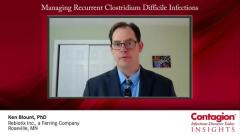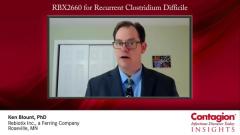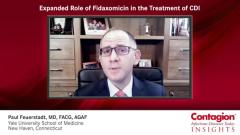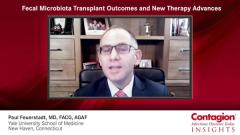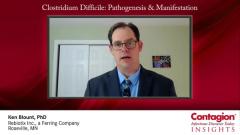
Clostridioides Difficile Pathogenesis & Manifestation
Episodes in this series

Transcript:
Ken Blount, PhD: I’d like you to think about C diff [Clostridioides difficile] infection as a disease in general. I would characterize this as the original microbiome disease. What I mean by that is there’s a very solid and clear link between the microbiome and C diff infection. It’s been known since roughly 1978 that C diff infections were the most prominent of a class of infection called antibiotic-associated diarrhea. It is what it sounds like. Antibiotics are administered to the patient and the patient develops diarrhea as an adverse effect. Now why is that? We think about the microbiome as being protection in our guts from invasion by host pathogens, C diff being a good example of one of those.
An analogy I like to use is to think about a really diverse and rich flower garden. We all can see seeds floating on the wind; some of them will occasionally take root, but if you were to clear cut that garden, those roots would have access to the soil. They’d spring up and take over the garden really quickly, and that’s what we see in the gut. The normal microbiome in a healthy gut is like that diverse garden, it has many different colors, flavors, and functions that help the gut function well. But when you damage that through the use of antibiotics for another reason, then you reduce that ability to resist colonization by C diff. C diff very often then will come in and take over, proliferate, and cause serious infection.
C diff itself is a gram positive, anaerobic, spore-forming bacteria. What does all that mean? It’s spore forming, meaning that C diff has the ability to form a very small spore, something like a seed that’s protected from the elements. Because of that, it easily spreads. It can spread through contact and fecal material, and that’s how it gets dispersed throughout a hospital system, which is one of the primary risk areas for C diff infection. I also mentioned C diff is anaerobic. That means that it needs to have an absence of oxygen to grow, and that’s important for its lifecycle. It doesn’t just grow anywhere, it only grows in the absence of oxygen with the exception of when it gets to be that sporiform.
When C diff is able to proliferate in that damaged microbiome, or the damaged garden of the gut, it actually grows, proliferates, and takes over the environment. You had asked about virulence factors—at that point it expresses its primary virulence factors, which are called toxins A and B. Both toxins A and B will cause changes in the shape and function of intestinal epithelial cells. It damages the cells and causes loose injunctions in the intestinal epithelium, which leads to a variety of symptoms, ranging from mild to severe. Milder symptoms are things like diarrhea, bloating, and cramping. More serious symptoms are severe cramping, severe diarrhea, severe intestinal inflammation, also known as toxic megacolon. It can be life threatening.
It’s a serious and very concerning disease, but it also has a lot of quality-of-life issues, particularly when it becomes a recurrent disease. Think about the challenges of being tethered to home. Patients are undergoing an awful lot of symptoms. It affects the quality of life, their ability to function at work and socially. It’s a real challenge for patients, and it’s a real unmet need that we’ve tried to address very early on.
Another aspect that’s very important with C diff infections is the likelihood for recurrence. Many times, roughly 25% of patients who get their first, or primary, C diff infection, are prone to develop a new recurrence of that infection. The reason for that is the standard of care for treating a C diff infection is an antibiotic, which although it kills C diff, the bacterium, it also very often damages the gut garden in which C diff has sprung up. Therefore, you’ve killed the weeds, but you still don’t have any flowers there to protect the garden against reseeding and reproliferation of those weeds. When we started Rebiotix Inc in 2011, it was with the recognition that something is needed to replenish that healthy microbiome of the gut. That’s the type of investigational therapeutics that we sought to develop.
Once patients advance to the stage of having a single recurrence, when they’re treated with an antibiotic, they’re very prone to have an additional recurrence. Patients who have a single recurrence will then have a much higher likelihood of having additional recurrences. Fifty percent or more of those patients will develop an additional, and an additional, and an additional C diff infection. It’s a challenge, particularly for the patients and definitely for the health care system as well.
The biggest risk factor is antibiotic, particularly broad spectrum antibiotics, and even more so, antibiotics that inhibit gram positive or anaerobic bacteria. Those are the ones where you’re going to see the highest risk factor. Health care setting is another risk factor, as well as long-term care setting, age, and the immunocompromised. Working downward in priority, all these are certainly risk factors for developing C diff infections, and in many cases, the more risk factors there are, the more likely the patients are to recur as well as contract that first infection.
Transcript Edited for Clarity
Newsletter
Stay ahead of emerging infectious disease threats with expert insights and breaking research. Subscribe now to get updates delivered straight to your inbox.

